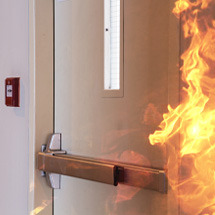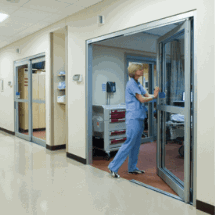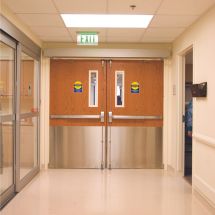A Beginners Guide to Automatic Door Hardware
February 15, 2021
With an abundance of different commercial door hardware and parts, how do you know what you need for your door!? We are hoping this post can help alleviate your concerns and help answer basic questions about options for commercial automatic sliding and swinging doors.
Different automatic door parts are needed for different types of doors: automatic sliding doors, automatic swinging doors, handicap door hardware for low energy ADA compliant doors, automatic bi-folding doors, automatic revolving doors and more.
When door parts are being used day in and day out, overtime, the excessive wear and tear can trigger a need for a replacement part to make sure your door(s) is running smoothly! Working doors mean lower energy bills, safer customers and employees (or students!), and accidents avoided! New or upgraded parts can help save you money over the life of your door and help avoid emergency support and maintenance costs.
Popular automatic door hardware includes but is not limited to:
Did you know there are standards in place for automatic door signage? If they aren’t labeled properly, then the people visiting your building may be taken by surprise if a door opens when they approach it.
Advanced Door Service has provided a blog post to outline these guidelines provided by ANSI (American National Standards Institute).
In researching the perfect definition of Automatic Door Sensors, we stumbled across this fun and simple explanation! Check it out here
Safety sensors such as beam sensors detect people or objects on the door track, where it is difficult to be detected by activation sensors.
An automatic door opens when the door control board receives an activation signal by the sensor to activate the gear motor to drive the belt and pulley. When no one is detected inside the activation area, the door starts closing after a designated period of time. A control board that adds significant value to Horton’s line of automatic sliding doors is the C3150.
An automatic door operator is a driving device that opens/closes the door. A Horton operator package includes the control and all components to automate a door.
For openings where automatic operators are feasible, automating the door allows optimal hands-free operation. Know the standards for these operators – BHMA A156.19 – Power Assist & Low Energy Power Operated Doors and BHMA A156.10 is for Power Operated Pedestrian Doors.
A door operator which is installed at or below the floor surface; usually an electro hydraulic or electro mechanic device.
Automatic door handicap push plates offer building access for the disabled or handicap. ADA accessibility is a must for any building owner. The visibility of a stainless steel handicap push button and the proper automatic door signage shows pedestrians that the entry way is automated. The push plate must be pushed for the door to open.
Low energy doors are often thought of as “handicap accessible automatic doorways”. These doorways usually have signage showing the universal symbols that are understood as wheelchair accessible openings. The doors are largely activated by a “knowing act”1 on the part of the doorway user. A button or push plate is used to activate the door operating mechanism.
Automatic door weatherstripping uses high quality bristles to conserve building energy and act as a barrier from outside elements and insects. Automatic door brush sweep kits from Horton Automatics are UL Listed and energy efficient, is effective up to -70 degree Fahrenheit.
Over time, the wheels found in the roller assembly of an automatic door may wear down or go out of alignment. This is a simple issue to have repaired by a professional, but it shouldn’t be ignored because the damaged wheel can ruin the roller and track assembly.
Touchless actuators are important tools for Americans with disabilities. It is wall mounted and allows doors to be operated by the wave of a hand are considered a knowing act by A156.19, but the detection range (the distance from the waving hand to the switch) should be no more than 12 inches. While there isn’t a specific allowable range for wireless transmitters, the user should be within view of the door before actuating the automatic operator, to help ensure that other building occupants are not in the path of the moving door.
The power to the door operator can be turned on/off easily with this switch during the maintenance of the door or off business hours.
A door-locking device designed to grant instant exit by pressing on a cross bar that releases the locking bolt or latch.
The mechanical device, connecting the operator to the door, which transmits motion and controls the closing speed of a door.
Automatic doors play a major role in the flow of pedestrian traffic entering and exiting a building. Like many other intricate systems, automatic doors require maintenance and upkeep. Overtime, these automatic door parts can become worn out and need replacing.
Advanced Door Service can help identify the industrial door hardware and parts you need and get them installed. We can also help you implement a preventative maintenance program for your doors to avoid costly and/or emergency repairs.
Our Advanced Door Service experts can help. Give us a call at 800-492-2392 or contact us through our website.
“Knowing act” – A user-controlled means of activating a door operator, i.e. wall switch, card reader, ceiling mounted pull cord switch, etc.1
Different automatic door parts are needed for different types of doors: automatic sliding doors, automatic swinging doors, handicap door hardware for low energy ADA compliant doors, automatic bi-folding doors, automatic revolving doors and more.
When door parts are being used day in and day out, overtime, the excessive wear and tear can trigger a need for a replacement part to make sure your door(s) is running smoothly! Working doors mean lower energy bills, safer customers and employees (or students!), and accidents avoided! New or upgraded parts can help save you money over the life of your door and help avoid emergency support and maintenance costs.
Popular automatic door hardware includes but is not limited to:
Commercial Door Decals and Safety Stickers
Did you know there are standards in place for automatic door signage? If they aren’t labeled properly, then the people visiting your building may be taken by surprise if a door opens when they approach it.Advanced Door Service has provided a blog post to outline these guidelines provided by ANSI (American National Standards Institute).
Automatic Door Sensors
In researching the perfect definition of Automatic Door Sensors, we stumbled across this fun and simple explanation! Check it out hereSafety sensors such as beam sensors detect people or objects on the door track, where it is difficult to be detected by activation sensors.
Automatic Door Control Board
An automatic door opens when the door control board receives an activation signal by the sensor to activate the gear motor to drive the belt and pulley. When no one is detected inside the activation area, the door starts closing after a designated period of time. A control board that adds significant value to Horton’s line of automatic sliding doors is the C3150.
Automatic Door Operator
An automatic door operator is a driving device that opens/closes the door. A Horton operator package includes the control and all components to automate a door. For openings where automatic operators are feasible, automating the door allows optimal hands-free operation. Know the standards for these operators – BHMA A156.19 – Power Assist & Low Energy Power Operated Doors and BHMA A156.10 is for Power Operated Pedestrian Doors.
Floor Mounted Operator
A door operator which is installed at or below the floor surface; usually an electro hydraulic or electro mechanic device.
Handicap Push Plates
Automatic door handicap push plates offer building access for the disabled or handicap. ADA accessibility is a must for any building owner. The visibility of a stainless steel handicap push button and the proper automatic door signage shows pedestrians that the entry way is automated. The push plate must be pushed for the door to open.Low energy doors are often thought of as “handicap accessible automatic doorways”. These doorways usually have signage showing the universal symbols that are understood as wheelchair accessible openings. The doors are largely activated by a “knowing act”1 on the part of the doorway user. A button or push plate is used to activate the door operating mechanism.
Automatic Door Weatherstripping
Automatic door weatherstripping uses high quality bristles to conserve building energy and act as a barrier from outside elements and insects. Automatic door brush sweep kits from Horton Automatics are UL Listed and energy efficient, is effective up to -70 degree Fahrenheit.
Automatic Door Wheels/Rollers
Over time, the wheels found in the roller assembly of an automatic door may wear down or go out of alignment. This is a simple issue to have repaired by a professional, but it shouldn’t be ignored because the damaged wheel can ruin the roller and track assembly.
Touchless Actuators and Wireless Transmitters
Touchless actuators are important tools for Americans with disabilities. It is wall mounted and allows doors to be operated by the wave of a hand are considered a knowing act by A156.19, but the detection range (the distance from the waving hand to the switch) should be no more than 12 inches. While there isn’t a specific allowable range for wireless transmitters, the user should be within view of the door before actuating the automatic operator, to help ensure that other building occupants are not in the path of the moving door.
Maintenance Switch
The power to the door operator can be turned on/off easily with this switch during the maintenance of the door or off business hours.
Exit Device
A door-locking device designed to grant instant exit by pressing on a cross bar that releases the locking bolt or latch.
Drive Arm
The mechanical device, connecting the operator to the door, which transmits motion and controls the closing speed of a door.Automatic doors play a major role in the flow of pedestrian traffic entering and exiting a building. Like many other intricate systems, automatic doors require maintenance and upkeep. Overtime, these automatic door parts can become worn out and need replacing.
Advanced Door Service can help identify the industrial door hardware and parts you need and get them installed. We can also help you implement a preventative maintenance program for your doors to avoid costly and/or emergency repairs.
Our Advanced Door Service experts can help. Give us a call at 800-492-2392 or contact us through our website.
“Knowing act” – A user-controlled means of activating a door operator, i.e. wall switch, card reader, ceiling mounted pull cord switch, etc.1





